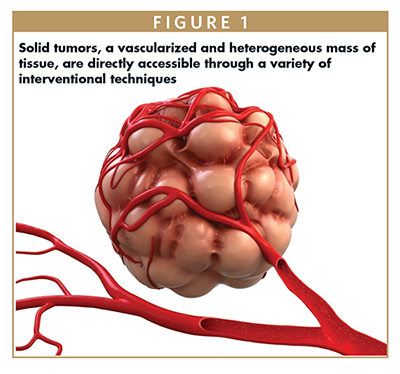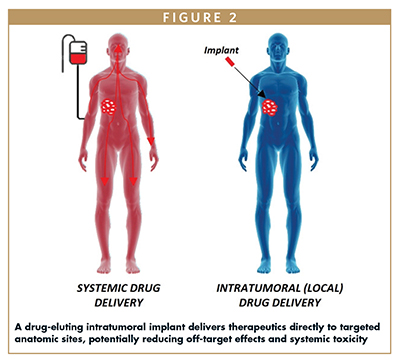Issue:January/February 2023
DRUG-ELUTING IMPLANTS - Sustained-Release Implants - A Targeted Approach to Drug Delivery
INTRODUCTION
While the pandemic created a catalog of challenges for the pharmaceutical industry, it created opportunities and learnings too – most notably in terms of the speed with which companies can transform new, innovative approaches, like mRNA vaccines, into market-ready products. The success of the COVID vaccine roll-out saved countless lives and raised the bar on what an acceptable time to market is. This demonstrates the levels of accomplishment that can be realized when industry, regulatory agencies and governments are sufficiently motivated. Building on this momentum, we have an opportunity to carry that game-changing mentality forward and apply it to other challenges.
Such positive, expansive thinking can deliver improved drug modalities, overcome long-standing therapeutic hurdles, and develop approaches that mitigate the historic challenges of targeted delivery, dose accuracy, and patient adherence.
THE OPPORTUNITY TO DEPLOY NEW LEARNINGS FOR ONCOLOGY TREATMENT
According to estimates from the World Health Organization (WHO) in 2019, cancer ranks as the first or second leading cause of death before the age of 70 years in 112 of 183 countries and ranks third or fourth in a further 23 countries.1
Cancer is a generalized name under which a multitude of diseases, each requiring a different therapeutic mode of action, are categorized. In terms of treatment options and patient outcomes, traditional routes of administration like oral, intravenous, and subcutaneous administration present their own risks and opportunities. In addition, patient acceptance, treatment burden, and the financial impact must also be considered. As new therapeutics are considered, we hope to move towards options that render obsolete the statement, “the treatment is worse than the disease.” As such, we propose exploring a new approach to treatment of some solid tumor cancers (Figure 1).

SUSTAINED-RELEASE IMPLANTS BASED ON GAME-CHANGING DRUG DELIVERY TECHNOLOGY
Used extensively for years in the delivery of contraceptive therapies, biodurable implantable drug delivery systems have a decades-long clinical history. However, there is still uncertainty in some quarters about the idea of implants for other types of therapies. Fueled by degrees of emotional response and supposition, there is a misconception they are too invasive to administer and after depleting their drug load, they need to be removed. The added safety and reliability benefits a biodurable implant may offer can be considerable, and the more implants are understood by practitioners, the more these benefits can be realized. It’s important to note that every type of cancer is different and requires unique solutions.
In a Celanese-commissioned research study conducted with medical and surgical oncologists, more than 80% expressed that an implant-based therapy would be attractive or very attractive based on improved efficacy and reduced toxicity. The clinicians surveyed cited a number of benefits expected to most significantly reduce the treatment burden for patients, including reducing the frequency of office visits, reducing drug administration times, reducing the frequency of dosing, and minimizing the “poking and prodding.”2

There is quite a bit of evidence to suggest implants should be considered (Table 1) and investigated more thoroughly and earlier in the drug product development process. Their ability to deliver drugs more effectively to a targeted treatment site, while addressing dose-limiting (systemic) toxicities, has the potential to overcome the inherent limitations faced with conventional forms of drug delivery – especially in effective targeting, lower toxicity. and patient adherence (Figure 2).

DRUG-ELUTING IMPLANTS CAN BRING NEW LIFE TO ESTABLISHED MEDICINES
Drug repurposing refers to reformulating an existing, marketed drug product by finding new routes of administration, indications, or therapy areas. We all recognize that the commercialization of new drug therapies requires at least ten years of development work and can represent around a $2.6 billion investment.4 Leveraging safety data from an existing drug and reformulating for new routes of administration, indications, and therapy areas (lifecycle management) is a key area of focus as pharmaceutical partners seek to continue building intellectual property.
There are several potential economic benefits to repurposing an existing drug for implantable drug delivery, including reduced development costs, intellectual property to extend the patent-protected life of a drug, increased market share, and an extended life cycle. Implantable devices can also resolve a currently unmet medical need. Patient empowerment increases with reduced reliance on medical staff intervention and supervision, enabling them to exercise greater agency and control of their lives. Most importantly, there is an opportunity to improve patients’ quality of life by potentially reducing the number of interventions, overall treatment burden, and the length and frequency of clinic visits.
IMPROVEMENTS IN TARGETING & BIOAVAILABILITY
It’s no secret most drugs do not reach the market. According to the National Institutes of Health (NIH), 80% to 90% of research projects fail before they ever get tested in humans.5 Some challenges that may result in the formulation being abandoned include poor solubility, limited bioavailability, high toxicity, and the inability to achieve sufficient drug concentration where needed. Poor absorption, distribution, metabolism, and excretion (ADME) properties are also among the factors that contribute to the failure of a drug to meet its market potential.
The proximity of an implant to the targeted region can increase the bioavailability of a molecule. As a result of localized implant delivery, lower drug volumes are needed to elicit the desired therapeutic effect. By optimizing the device to meet the needs of each drug, there is an opportunity to ensure the greatest clinical benefit for the patient. Simply put, implantable devices deliver the right drug, in the right place, at the right time.
Implantable drug delivery systems also present formulators with an opportunity to improve success rates by reducing the likelihood of off-target effects, which may improve patient tolerance.6-8 By implanting the device close to the site of action, there is an opportunity to reduce systemic exposure and mitigate the damage caused to healthy cells.
A CRITICAL BALANCE BETWEEN EFFICACY & TOXICITY
Healthcare providers (HCPs) are often faced with a precarious balancing act, working to maintain treatment while mitigating the adverse effects of what are very often highly toxic drugs. Many chemotherapies and immunomodulators have major to minor toxicities. For example, pulmonary toxicities include interstitial pulmonary fibrosis (IPF), usual interstitial pneumonitis (UIP), pneumonitis, radiation recall-pneumonitis, and alveolar hemorrhage.9
Consequently, when presented with toxicity effects, HCPs will pull back on treatment frequency or dosage and, in some cases, end the treatment regime. This is clearly a far from optimal outcome for patients, and one that may be avoided with a more targeted, sustained-release delivery mechanism.
CARING FOR THE HUMAN, NOT JUST THE PATIENT: A GAME-CHANGING OPPORTUNITY
Cancer and the therapies it demands impact patients’ lives in all kinds of ways. Everyday life is limited or otherwise impacted due to fatigue, nausea, or pain, and there is the burden of numerous and time-consuming visits to clinical settings. Implantable devices offer several patient-centric benefits to overall well-being and improved mental health, as well as relief from some of the physical cost, time, and stress of repeated hospital or clinic visits (Figure 3).

AN OPPORTUNITY TO REIMAGINE DRUG DELIVERY, A CHANCE TO BE BRAVE
If the pandemic has shown us anything, it is that important innovations can be brought to market quickly, when propelled by the right resources, collaborations, and commitment. Oncology requires new treatment modalities that are better for patients, and it is time technologies like drug-eluting implants are more widely considered. Implantable sustained-release drug delivery devices offer real, achievable advantages: sustained continuous dosing, potential to improve drug-delivery efficiency by concentrating the drug where it is needed most (while minimizing systemic exposure and any resulting side effects), and built-in adherence.
REFERENCES
- World Health Organization (WHO). Global Health Estimates 2020: Deaths by Cause, Age, Sex, by Country and by Region, 2000-2019. WHO; 2020. Accessed December 11, 2020. who.int/data/gho/data/ themes/mortality-and-global-health-estimates/ghe-leading-causes-of-death
- Celanese-commissioned survey of 75 medical and surgical oncologists.
- Polymers (Basel). 2018 Dec; 10(12): 1379. Published online 2018 Dec 12. doi: 10.3390/polym10121379
- Joseph A. DiMasi, Henry G. Grabowski, Ronald W. Hansen, Innovation in the pharmaceutical industry: New estimates of R&D costs, Journal of Health Economics, Volume 47, 2016, Pages 20-33, ISSN 0167-6296, https://doi.org/10.1016/ j.jhealeco.2016.01.012.
- https://transmedcomms.biomedcentral.com/articles/10.1186/s41231-019-0050-7
- Langer R. New methods of drug delivery. Science. 1990;249:1527–1533. doi: 10.1126/science.2218494.
- Rajgor N., Bhaskar V., Patel M. Implantable drug delivery systems: An overview. Syst. Rev. Pharm. 2011;2:91–95. doi: 10.4103/0975-8453.86297.
- Dash A., Cudworth G. Therapeutic applications of implantable drug delivery systems. J. Pharmacol. Toxicol. Methods. 1998;40:1–12. doi: 10.1016/S1056-8719(98)00027-6.
- https://www.cancertherapyadvisor.com/ home/decision-support-in-medicine/critical-care-medicine/life-threatening-toxicities-of-chemotherapies-and-immunomodulating-medications/.

Tom Quinci has a diverse background in the development of therapeutic delivery systems, including drug products and interventional medical devices. At Celanese, he is responsible for developing strategic commercial partnerships and technical collaborations, while also leading ideation and concept development for applications in oncology, ophthalmology, and central nervous system disorders. Prior to Celanese, he held positions at DSM Biomedical and W.L. Gore and Associates, where he led key programs for orthopedics and electrophysiology. He earned his Bachelor’s degree in Mechanical Engineering and a Master’s degree in Engineering Management. He completed post-graduate programs through the Oklahoma Heart Institute and Wharton School of Business.
Total Page Views: 6243









